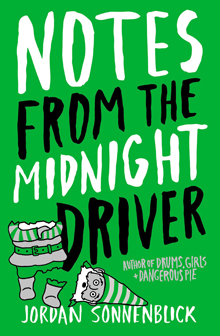 Like many of our middle school students, Alex’s life is in turmoil. His parents are in the midst of a very expensive divorce and his college fund is quickly depleting as lawyers battle over his time. Compounding that, Alex’s dad has moved in with his third-grade teacher and his mom has started dating. He has had enough. So Alex gets drunk, takes the keys to his mom’s car, and heads out to give his dad a piece of his mind.
Like many of our middle school students, Alex’s life is in turmoil. His parents are in the midst of a very expensive divorce and his college fund is quickly depleting as lawyers battle over his time. Compounding that, Alex’s dad has moved in with his third-grade teacher and his mom has started dating. He has had enough. So Alex gets drunk, takes the keys to his mom’s car, and heads out to give his dad a piece of his mind.
Of course, things do not go as planned. Alex finds himself in police custody having decapitated a neighbor’s garden gnome. His actions land him with a strict grounding at home, teasing at school, and assigned community service at a local nursing home with a notoriously cantankerous patient.
The beautifully composed story perfectly blends poignant moments with the humor that typically follows the lives of early adolescent students. Readers easily connect with Alex’s plight while seeing his character develop as he becomes less self-centered and learns how to serve others.
Cross-curricular Connections: English language arts, social studies/history
Ideas for Classroom Use:
This book lends itself to several different types of activities to support all of our diverse learners.
Cause and Effect
Notes From The Midnight Driver provides students with many opportunities to evaluate cause and effect relationships. Students can discuss and reflect on Alex’s choices and answer questions like What could have been done differently? What would have been a different outcome? In addition to having large and small group discussions, blogging is a great platform for students to share their thoughts. Unlike oral discussions, blogging gives students more time to contemplate, form their own ideas, and then share them with their peers. Through blog commenting, students can hold ongoing conversations outside of the classroom
Character development
In our classroom, we will use a “plot mountain” graphic organizer to study how Alex’s character develops and to analyze how Sonnenblick creates a character that the audience can identify with. Students will use that as a model and create a character for their own narratives.
Letter writing
Although we live in the age where digital mediums reign our interpersonal communication, Alex uses letters to communicate with the judge on his progress. This lends itself to a discussion about communication mediums, audience, and impact. Students can select a topic, such as the dress code or the equitable use of physical education equipment, and determine how that would be communicated to a friend, a kindergartner, a parent, a grandparent, or a superintendent. Students can then compose their message for different audiences using different tools. They have to ask themselves, Would I text message, e-mail, Tweet, or write a letter explaining my argument? This is an authentic opportunity for students to practice communicating their message across different mediums for different audiences.
Living history
This book inspires readers to learn from the wisdom and experiences of older generations in their communities. Students can interview persons of interest, record their stories and then publish them to share with future generations. Some of my students favorite ways to publish are through video (iMovie or We Video), digital picture books (Mystorybook or Storyjumper), graphic novels, blog posts (KidBlog), and animation (StikBots or PowToon).
Service learning projects
Students want to know that what they are learning in school is relevant to their lives and empowering them to make a difference in the world. Although Alex is assigned community service, he eventually becomes invested in providing the residents at the nursing home, especially his assigned patient, with a jazz concert. This sets an example for students to really examine their communities, identify an area that may be underserved, and use their own talents to provide a service that positively impact the lives of others.
Through many of these learning experiences, students will develop empathy for others while promoting social justice in their own communities.
Additional Resources:
Jordan Sonnenblick's official website links to Sonnenblick’s full list of books, his calendar, blog, and other resources.
"Service-Learning: The Time is Now" is an article explaining why service learning projects are powerful for our students. The article provides several examples of successful projects as well as steps for classroom implementation.
Julie D. Ramsay is a National Board Certified Teacher and the author of Can We Skip Lunch and Keep Writing? She teaches ELA to sixth graders at Rock Quarry Middle School in Tuscaloosa, AL. She also travels the country to speak, present, and facilitate workshops in applying technology to support authentic learning. Read her blog, eduflections.
Julie D. Ramsay will facilitate a workshop titled “Putting Books to Work Mid-Level” (featuring authors Jordan Sonnenblick, Pablo Cartaya, and George O’Connor) at the ILA 2017 Conference & Exhibits, held in Orlando, FL, July 15–17.